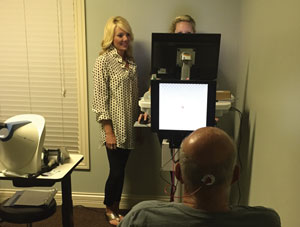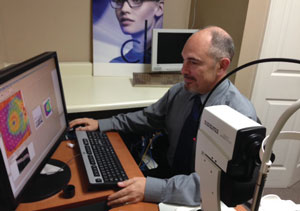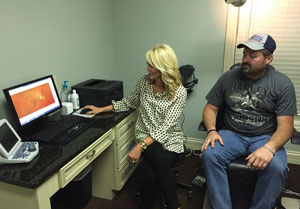For Milton Hom, OD, of Azusa, Calif., the idea of adopting the medical model in eye care is similar to HBO’s sitcom Silicon Valley, which follows six entrepreneurs who found a start-up company. “To ensure survival, they learn that successful companies ‘pivot’… take what you have and change directions,” Dr. Hom says. “When I was in optometry school, the medical model was unheard of; now, it’s the present and future of optometry.”
As scope of practice laws have progressed in the majority of states, many optometrists have “pivoted” their practices from focusing entirely on routine eye exams to treating medical conditions such as dry eye, glaucoma and AMD, with the dual benefit of additional revenue and patient retention.
 | |
| Dr. Sutton runs a VEP with a glaucoma patient. |
But if you’ve recently transitioned to a medical model or have been at it for several years, how can you ensure you are getting the most out of it? Here are seven questions you can ask yourself—and the answers shared by successful ODs who’ve been able to turn their medical practices into a success.
1. Is My Staff Properly Trained?
Staff should always be educated on correct medical billing and medical insurance when you adopt a medical model, says Bryan Rogoff, OD, of Baltimore, Md. Education should be ongoing with updates provided during monthly meetings, he adds, considering insurance companies’ policies are always changing. He also stresses the importance of staff education and its impact on patient satisfaction and customer service. “If staff doesn’t understand medical coverage and what your practice can bill [for] and [they bill for something that’s] not covered, the bill comes back to the patient. Obviously, this is inconvenient and the patient isn’t happy.”
TeShawna B. Sutton, OD, of 20/20 Eyecare in London, Ky., trains her staff to look back at previous exams to determine if a glaucoma suspect, for example, has had the proper tests run and to alert the doctor if anything is missing. “That’s why training staff on disease processes is important. They can be a huge resource to help keep us on track,” she says.
Staff training on equipment is also critical, as reliable and reproducable test results depend on properly executed tests, she adds. For example, staff needs to understand how important it is for a patient to maintain proper fixation during a visual field, she says.
“We have trained our staff on what a hemoglobin A1C means and why it’s important that we ask. They also know how important communication with the primary care physician is for a diabetes patient, so staff routinely asks for the doctor’s name and contact information. These small steps are integral to our efficiency and ultimate success,” Dr. Sutton says.
2. Am I Getting Reimbursed in a Timely Fashion?
Thirty is the magic number when it comes to reimbursement. You should aim to receive reimbursements in 30 days or less, Dr. Rogoff says. This often comes down to making sure there are no errors when you bill the insurance company, which can result in denied claims if you’re billing for something that isn’t covered. Timely reimbursement is integral to business success, as it ensures you can pay your bills and payroll without complications, Dr. Rogoff adds.
 | |
| Dr. Diecidue reviews an OCT of the retina for indications of diabetic retinopathy. |
“It’s great if you get paid a certain amount for glaucoma procedures, but if you don’t get reimbursed for 60 days and you have bills to pay within 30 days, this can be a problem. In the medical model, cash flow is critical.”
3. Am I Billing Correctly?
Staff needs to be adept at knowing how to bill for medical visits; otherwise, your boat will sink, says Anthony Diecidue, OD, of Stroudsburg, Pa. Medical visits are almost exclusively covered by medical insurance, so if you and your staff aren’t trained in medical billing, it could put a severe financial strain on your practice.
Documentation is the key to staying organized and ensuring you are billing correctly, Dr. Sutton adds. Documenting everything will help you prove medical necessity—which all insurance companies demand—as well as keep track of what tests are accepted by certain carriers. Each insurer will be a little different, so “make sure you know your limits on testing with the different carriers,” Dr. Sutton says. For example, different insurers have different rules about what tests can be done on the same day or when a test needs a modifier or is a bilateral procedure, so understanding the specifics of each code you are using is key.
“We tend to know what we want and what we need inside our heads, but there are rules for every test and limits for the number of times a test can be performed.” Dr. Sutton says. At Dr. Sutton’s practice, staff uses a coding verification website on a daily basis to make sure proper diagnosis codes are linked to proper procedure codes, she says.
| The Medical Model: Where to Start? If you’re thinking about adopting a medical model but aren’t sure what conditions to treat, Dr. Hom suggests starting with allergy. “Prescribing an antihistamine drop and monitoring its effect is an easy first step,” he says. Another area in which to get your feet wet in the medical model is diabetic retinopathy fundus exams, Dr. Hom says. “Most primary care physicians require them, so the need is already built in.” In-office treatment of Demodex, although generally not covered by insurance, is another potential area to explore, he says. |
You also should be careful about submitting documents that include red flags because of your billing patterns, Dr. Rogoff says. “Sometimes when you jump into a medical model of eye care, you may think you need to get reimbursed for everything, but it can snowball, so be sure you are billing for what’s medically necessary,” he adds. He cautions against overbilling, performing procedures that are not covered or administering specific tests to every patient without cause—all of which could be red flags and put your practice under the insurer’s microscope.
4. Is My Practice Patient-Centric?
Jack Schaeffer, OD, of Birmingham, Ala., describes the medical model, which he prefers to call the integrated health care model, as 100% patient-centric and a comprehensive approach to care.
“The definition of an integrated health care model is working within the entire patient’s medical community of doctors and ancillary personnel to ensure a long, healthy life for the patient. So that’s working with their primary care doctor, endocrinologists, gastroenterologist and rheumatologists, depending on each patient’s condition or wellness factor,” he says.
Even if patients are coming in for a routine eye exam, the office should be prepared if the patient needs more comprehensive care.
“It’s important the staff understands, from the time that patient enters your office, they are entering into an integrated health care model. The patient may look healthy and only need glasses or contacts,” Dr. Schaeffer says, but oftentimes there may be more to the story. For example, pediatric patients who are developing myopia will need preventative care and patients with diabetes may need more testing during their routine exam—not to mention communication with their endocrinologist.
The concept of a patient-centric practice also means talking about protective eyewear for children who play sports, discussing blue light-blocking lenses with patients who use electronics on a daily basis, offering ocular vitamins and performing a complete evaluation for dry eye and other ocular surface diseases in patients who are at risk before a contact lens evaluation, Dr. Schaeffer adds.
5. Am I Getting Referrals and More Calls for Medical Visits?
Within months of launching a medical model, optometrists should expect to receive more calls for medical-related visits—and doctors can generate some of these additional visits themselves, Dr. Diecidue says. “If you see a patient for a regular eye exam and you notice they have a hemorrhage in their retina and they’re diabetic, this person needs a specific evaluation.” Take note of medical conditions, such as these, that warrant further evaluation, Dr. Diecidue says. You can then educate your patient on the medical services you can provide and schedule follow-up testing.
Likewise, if a patient has risk factors for medical conditions such as glaucoma or retinal detachment that could have heredity components, you can suggest other members of the family be examined, Dr. Diecidue says.
 | |
| Dr. Sutton reviews a retinal image with a diabetes patient. |
Now that you have a medical model, it is important to form relationships with other specialists in your area that may refer patients to your practice, Dr. Diecidue adds. In his community, Dr. Diecidue forged professional relationships with pediatricians, emergency room nurses, internists and other primary care physicians who now often refer to him if they see a patient with an eye-related medical condition. Dr. Diecidue also approached non-medical members of his eye care community who don’t do advanced testing who now routinely refer to him.
6. Do I Have the Necessary Equipment and Physical Space?
If you are just getting set up to adopt the medical model, make sure your practice can handle the added equipment and caseload, Dr. Schaeffer says. While a non-medical practice can flourish with a dispensary and one exam room, the medical model demands a lot more space—and technology. “It’s important your physical plant shows you are there to take care of the patient, whether that means medical, glasses or contacts, or just an eye exam. You need equipment necessary to do the work,” Dr. Schaeffer says.
For example, in glaucoma treatment, an optometrist would need a perimeter, pachymeter, OCT, retinal camera and gonioscope. “Those are minimal requirements to truly follow a glaucoma patient in your practice, and you’d report those findings to the patient’s primary care physician,” Dr. Schaeffer says.
Beware of Structural Impediments
The most significant structural impediments preventing optometry from doing better at transitioning to primary eye care revolve around the issues of access and parity. Until they are resolved, the medical model cannot be fully implemented. |
Just because you take on more medical services doesn’t mean you need to buy every piece of equipment available. “If you don’t have an OCT, that’s fine, as long as you have access to one and your glaucoma patient has an OCT test done on regular intervals of six months to a year,” Dr. Schaeffer says.
7. Are My Books and Schedule Balanced?
When you adopt the medical model, expect to spend more time in the exam room. “With a routine eye exam, you can almost clock how much time you’ll spend with a patient. You need to adjust your schedule to accommodate patients there for medical visits, especially ones with multiple medical issues. You don’t want to rush through these exams,” Dr. Diecidue says.
A lot will change in your practice with the adoption of the medical model, including the need for more technicians and longer patient appointments—both of which are going to cost you, Dr. Schaeffer says. “Integrated health care is a low-volume, high-cost model,” he explains. “It can’t be high-volume, low-cost or even high-volume, medium-cost.
“Some patients will select out, so be prepared to lose some patients,” he adds.
Dr. Rogoff suggests adding hours to your practice’s schedule if you already have a full book and strong productivity. “If you have 60% to 70% activity in your books because you’ve added a medical model, you need to extend your book,” he says.
Once you start a medical model, be sure to watch revenues on both sides of your practice. The medical revenue will undoubtedly increase, but also keep an eye on how it affects the optical and contact lens side to find the right balance, Dr. Rogoff says.
“Optometry students today come out of school well prepared to institute a medical model immediately,” says Dr. Sutton. “With refractive plans becoming more and more popular and ophthalmology being overly busy, we stand to really make our practices profit from using what most of us are already doing anyway. You can become an integral part of your patients’ primary care team, and I think that’s a goal we should all set for ourselves.”
